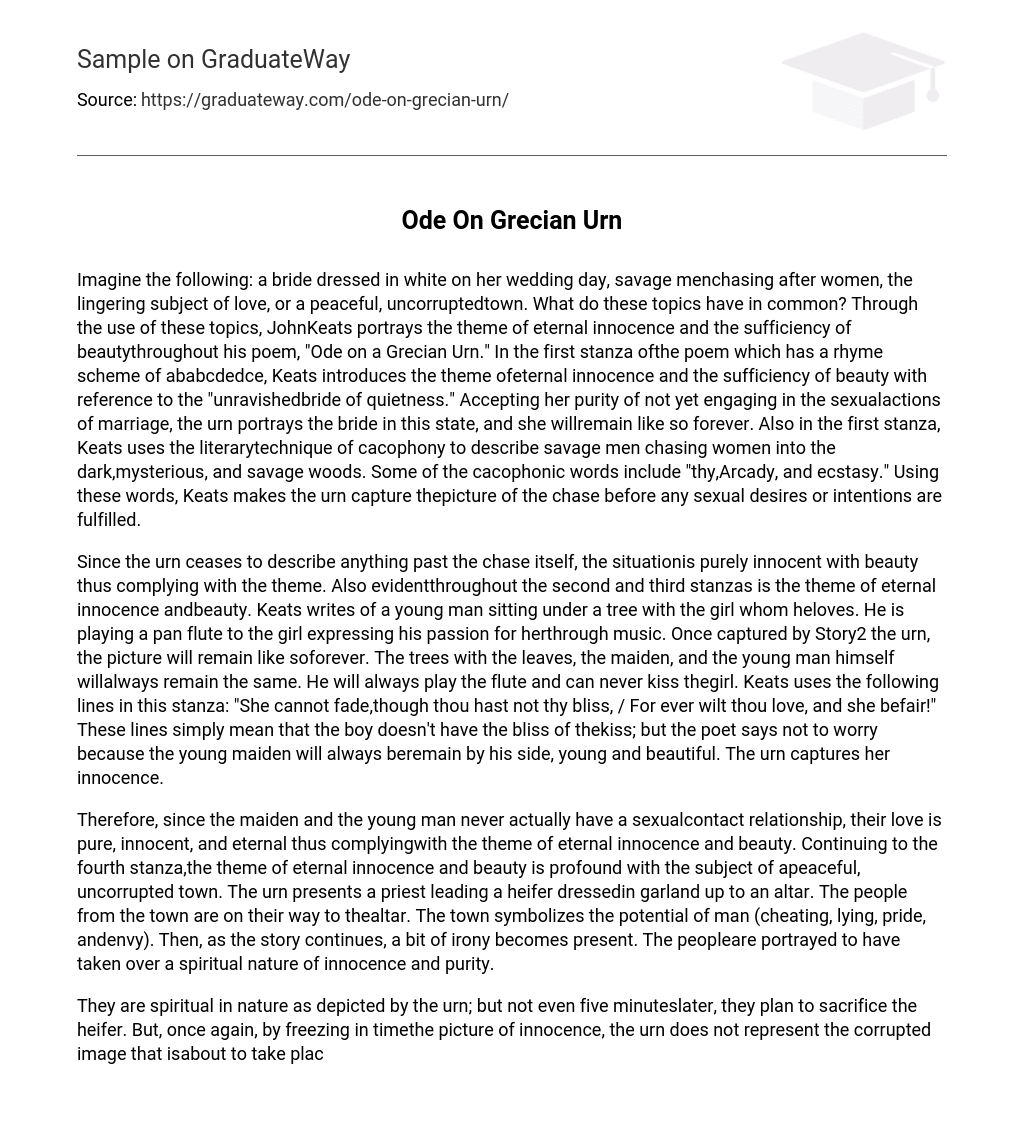Imagine the following: a bride dressed in white on her wedding day, savage menchasing after women, the lingering subject of love, or a peaceful, uncorruptedtown. What do these topics have in common? Through the use of these topics, JohnKeats portrays the theme of eternal innocence and the sufficiency of beautythroughout his poem, “Ode on a Grecian Urn.” In the first stanza ofthe poem which has a rhyme scheme of ababcdedce, Keats introduces the theme ofeternal innocence and the sufficiency of beauty with reference to the “unravishedbride of quietness.” Accepting her purity of not yet engaging in the sexualactions of marriage, the urn portrays the bride in this state, and she willremain like so forever. Also in the first stanza, Keats uses the literarytechnique of cacophony to describe savage men chasing women into the dark,mysterious, and savage woods. Some of the cacophonic words include “thy,Arcady, and ecstasy.” Using these words, Keats makes the urn capture thepicture of the chase before any sexual desires or intentions are fulfilled.
Since the urn ceases to describe anything past the chase itself, the situationis purely innocent with beauty thus complying with the theme. Also evidentthroughout the second and third stanzas is the theme of eternal innocence andbeauty. Keats writes of a young man sitting under a tree with the girl whom heloves. He is playing a pan flute to the girl expressing his passion for herthrough music. Once captured by Story2 the urn, the picture will remain like soforever. The trees with the leaves, the maiden, and the young man himself willalways remain the same. He will always play the flute and can never kiss thegirl. Keats uses the following lines in this stanza: “She cannot fade,though thou hast not thy bliss, / For ever wilt thou love, and she befair!” These lines simply mean that the boy doesn’t have the bliss of thekiss; but the poet says not to worry because the young maiden will always beremain by his side, young and beautiful. The urn captures her innocence.
Therefore, since the maiden and the young man never actually have a sexualcontact relationship, their love is pure, innocent, and eternal thus complyingwith the theme of eternal innocence and beauty. Continuing to the fourth stanza,the theme of eternal innocence and beauty is profound with the subject of apeaceful, uncorrupted town. The urn presents a priest leading a heifer dressedin garland up to an altar. The people from the town are on their way to thealtar. The town symbolizes the potential of man (cheating, lying, pride, andenvy). Then, as the story continues, a bit of irony becomes present. The peopleare portrayed to have taken over a spiritual nature of innocence and purity.
They are spiritual in nature as depicted by the urn; but not even five minuteslater, they plan to sacrifice the heifer. But, once again, by freezing in timethe picture of innocence, the urn does not represent the corrupted image that isabout to take place. It has caught the people in a holy moment, and it hascaught the town as an empty picture of beauty. Therefore, Keats once againdemonstrates eternal innocence and beauty by capturing on the urn the picture ofan uncorrupted town and a group of holy people. In the last stanza, Keats tellsthe reader he has teased their thought by convincing that the theme of innocenceand beauty are ever present in society. This last stanza leaves the reader withmixed emotions as a result of the mixed imagery. This means that the narratorvoices Story3 protests of the superiority of the world captured in the Arcadianscenes (first stanza), but is perplexed by the unanswered questions stemmingfrom the silence of the “Cold Pastoral” in the last stanza. He isprimarily trying to tease the thought process by making the reader think ofsomething eternal. Also adding to the confusion is the most famous part of thepoem that lies within the couplet at the conclusion of the ode. Keatsmetaphorically penned these lines: “Beauty is truth, truth beauty,–that isall/ Ye know on earth, and all ye need to know.” It is said that even Keatswas not clear of the exact message presented by this statement. Most criticsthink he used the terms of truth and beauty in a Platonic sense, as verbalrepresentations of the highest ideals. The first part of the statement isrelatively clear-the highest expressions of art are the most sublime expressionsof wisdom and truth. But, the last part of the message leaves a lingering sense.
Maybe he thought only the beautiful parts of life should be represented which iscomparable to the images on the urn. But, only Keats knew the real meaning.
Overall, this last stanza forces the reader to see what is in the surroundingworld. It foresees that when there is a presence of “other woe” withinthe world (which is relevant to the world today: 180 years later), the urn andits eternal emanations of beauty will survive. So, even though the last stanzais of a different structure (does not have the urn representing a scene), itstill represents innocence and beauty especially within the famous line”Beauty is truth, truth beauty”. And therefore, as demonstratedthroughout the entire poem by the use of innocent, unfulfilled images painted onthe urn, Keats demonstrates the theme of innocence and eternal beauty.





